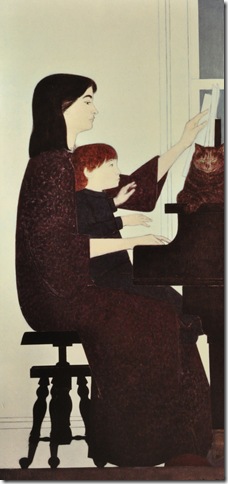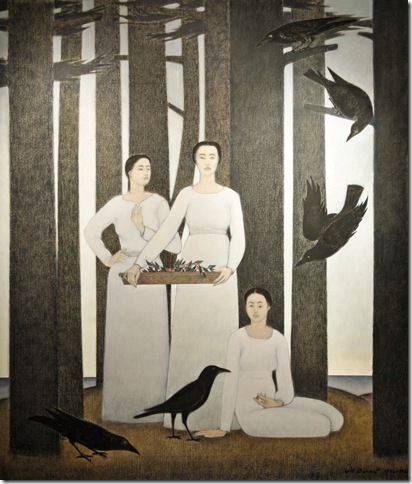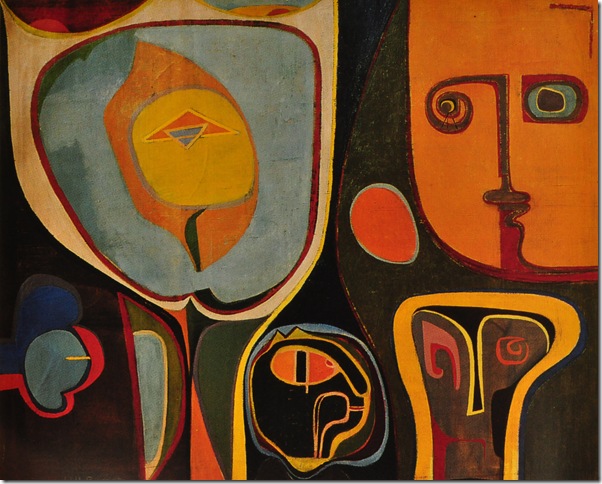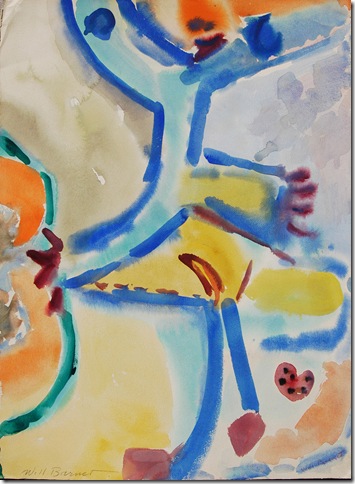Forget garlic: When it comes to art, passion and honesty will get you far or, at least, get you to live forever.
In case you have any doubts, the Boca Raton Museum of Art is currently offering a large dose of pieces by an artist who has always been far from extravagant and is now about to turn 101 years old.
Will Barnet at 100: Eight Decades of Painting and Printmaking is proof that immortality is not reserved only for artists who shock, stick to their found style or follow the artistic waves of the moment. There also is room for the artist who does things of his own accord, leaves his found style to discover another, and produces work that is simple and quiet. And in this case, there is a lot of room.
The artworks on display range in variety from watercolors and drawings to oils and prints. They offer realism, cubism and abstraction and represent the years 1935 to the current year of 2012, although not in chronological order.
Youth and The Studio, to me, carry the same grace and simplicity. There is no despair. No sense of urgency. No use of shadows. These two paintings are 26 years apart. The first, Youth, is from 1970 and depicts Ona, the artist’s daughter, extending her left arm in a pose similar to that found on Egyptian wall paintings. Her dark hair falls on her shoulders. Her skin is very pale. At the sight of a golden bird, a black cat (which looks more like a panther) takes a bow, its tail curved in scorpion-like fashion. Her long black robe ends long before her ankles to make space for a touch of rich purple serving as underskirt.
The second work, from 1996, shows an artist with a brush on hand. Straight lines define the body covered in a black coat and turtleneck. A child extends both arms as if trying to reach the canvas set on the easel. A cat rests on a high window while a parrot poses for a portrait. In both cases, the human figures avoid looking at us.
 Barnet’s themes are rather simple, minimalist, serene and happy to exist just as they are. There is no need to look for hidden motives for most of the works capture family, children and animals (particularly cats) in ordinary moments of daily life. In that sense, the works are very honest.
Barnet’s themes are rather simple, minimalist, serene and happy to exist just as they are. There is no need to look for hidden motives for most of the works capture family, children and animals (particularly cats) in ordinary moments of daily life. In that sense, the works are very honest.
How exactly the artist manages to make these unimpressive moments extraordinary I am not sure. One thing I know: Will Barnet is not an old man.
His works are mostly flat, carry thin layers of paint and straight, clean lines. Nothing is ever accentuated or too loud. It is as if, from a young age, his emotions had surrendered to quietude and orderly structure. After seeing what he does and how he does it, one cannot conceive these same figures in any other way than how he presents them.
I am particularly touched by his use of color, which is lovely. In some paintings, he stays within the range of a color’s family, carefully stepping in and out of its territory. His use of subtle variations end up giving two impressions: there is either one color or dozens of colors in one work.
At the beginning of the show you are introduced to The Lesson (1983-84). The tone used on the woman’s gown is not the same as that used on the cat sitting on the piano nor is it equal to that given to the boy’s hair. And yet, the proximity of all the colors gives the entire work a sense of harmony and unity.
Something similar happens with Dusk (1976-77). This time a family of blues has inundated the canvas where a woman has momentarily abandoned her book to look at the cat resting by her side. They are all blue, but no single color repeats itself.
In other pieces, such as Ellie in Blue (2002) and Return from Paris (1990-99), Barnet opts for contrasting combinations. He dresses a girl in blue against a mustard-yellow space and gives a green coat to an elegant gentleman standing before a warm orange sky.
A sharp separation of tones happens in Seventh Season, a 1975 color serigraph, where white serves as primary background color. A white cat rests on the window frame looking at a chess match not long from ending. The sky is painted blue. One hand extends from the right to hold the white king while a girl wearing a bright orange dress rests her chin on her hand waiting for her turn. She may have already lost, although we cannot be too certain. After all, she has a black pawn approaching the other end of the board where she can claim her queen back and, who knows, maybe a victory.
Besides the Egyptian-like mannerism and flatness, you may notice there is a certain oriental quality to his female figures. These appear dressed in long loose robes featuring long black hair, pale skin and graceful features.
You can see it on Dialogue in Green (1970) as well as Dawn (1975). The latter one is a contemplative piece depicting a woman on a roof terrace looking out in the distance. Her skirt moves with the wind, unlike her hair, which is wrapped in a bun. Barnet lets a window of the house be seen but there are no lights on and nobody can be seen through it. I get the sense this is not the first time this woman has come to this spot to see the dawn.
At one point, you will come across abstract works full of symbols, strange patterns and colors. That is not a wrong turn. You are still looking at Barnet pieces; these are just completely different. Seemingly more organic and less controlled, these works derive from Barnet’s consistent interest in Native American history and the ancient past in general.
It is a rare surprise to find an artist brave enough to find new ways of expression, even if in doing so he will be less recognizable. Barnet has always been true to no one else but himself. That philosophy helped earn him the National Medal of Arts from President Obama about two months ago.
Although a lot of attention goes to the fact that he is 100 years old, still alive and still painting, his age should really take a back seat while looking at his work. We would not want to confuse sympathy for admiration and feel one when we mean to feel the other.
Age does not mean a thing. Not in art. One can be young and brilliant; old and mediocre. Few are good at all ages.
But if you are curious to know what being consistently good looks like, go see the show.
Will Barnet at 100: Eight Decades of Painting and Printmaking runs through May 20 at the Boca Raton Museum of Art. Admission:$8 adults, $6 seniors, $4 students. Hours: 10 am-5 pm Tuesday, Thursday and Friday; 10 am-9 pm Wednesday; 12 pm-5 pm Saturday and Sunday. Closed Mondays and holidays. Call 561-392-2500, or visit www.bocamuseum.org.



